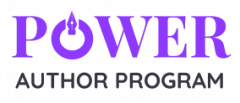NEW: Guided Publishing Experience: POWER Anthologies – Apply NOW!
Emerging>> Your Content Roadmap Overview
Make a copy of the Content Workbook.
The Workbook has 4 tabs.
- Start with You
- Your Audience
- Voice of Customer Data
- Content Roadmap
Start with YOU
- Start with your own long-, medium-, and short-term goals. I’m not going to give you set periods for these, as they differ between industries and people.
- Make an honest assessment of how far from your goal you are, and what needs to change if you are going to achieve your goals.
- Consider the strategies you might employ. This is the broad strokes approaches you might take.
- Next consider the objectives you can set as milestones along the way. These are measurable and can take deadlines.
- Finally think about the tools and tactics you might use to meet your objectives. This is HOW you are going to hit your targets.
Your Audience
- Now you know what you want to achieve, it’s time to turn your attention back to your audience.
- Think about who you need to serve to achieve your long-term goal.
- Break this down into the types of people you might need to talk to.
- Finally decide the best way to segment and group your audience.
- Brain dump all the problems each segment of your audience has, whether you can help them with those problems or not.
- When you have a reference list of problems, run through the Urgent, Critical, Painful exercise for each of your major personas.
- Use this information to identify your Four-Figure Fixes
- Now give each of your major personas a name and fill out the grid with their roles, goals, challenges, questions, and solutions.
- Now that you know your audiences’ goals, return to your goal, and identify the action you want the persona to take, and the belief they need to have to take that step.
Voice of Customer Data
- Make a reference list of the places where you know your audiences spend time together. You will come back to this list and add to it regularly.
- Look at the kinds of content that your audience likes and dislikes in those hangouts.
- Look at the kinds of ads your audience are served and which they engage with most.
- Keep a list of the questions your audience asks, the complaints they make, the wishes they voice, and the wins they share in those spaces. Keep separate lists for each major persona.
- This Voice of Customer Data will help you fill in your Content Roadmap.
Content Roadmap
- Consider your personas, most wanted responses and problem statements considering the Voice of Customer data you have found. Do you need to update them?
- Look at your client journeys as populated by the work you have done so far. Use your VOC data to complete the topics that will help them move through the steps of that journey towards their goal and your most wanted response.
- Now look at the content library overview and split the topics into separate cells. You also have room to add here content you want to add to help you achieve your own goal.
- Now look at the content roadmap. Add the main message and takeaways, headline ideas, media, and channels you might use when you create this content for each line item.
- In the final column, “Include in Plan?”choose no more than one piece of content per persona per stage of the journey to create content for in your next quarterly campaign. Try to choose topics that will follow on naturally to lead each persona to their goal and to take your most wanted response action.
- Your final content plan will give you the title, content, format, and channels for the content for each persona at each stage of their journey that you have chosen to include in your content campaign.
- You DO NOT have to have an item of content for each persona at each stage of the journey for every campaign. You might run a campaign with content for every persona at a specific level, or a campaign with content for a single persona at each stage of the journey.
- Only put as much content into you campaign plan as you are confident you can create and share in 90 days.
